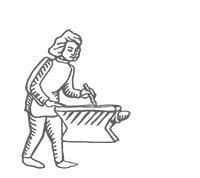|
Daniel Hudon Desert Rat-Kangaroo Here, gone; here again, gone again. Almost a century between sightings. A legendary runner, once chased for twelve miles across the hard-packed gibber plains in the heart of Australia. Barely seen in the distance where seeming scarcely to touch upon the ground, it almost floated ahead in an eerie, effortless way. Easily tiring a relay of three galloping horses. Its speed, for such an atom, was wonderful, and its endurance amazing. Caloprymnus for “beautiful rump,” alluding to the exquisite shape of its powerful hind legs; and campestris, to its habitat, “plain, level country,” altogether less musical than the Aboriginal: oolacunta. Sometimes known as the buff-nosed rat-kangaroo, the oolacunta was the size of a small rabbit, had a small muzzle, narrow ears and sandy brown fur that blended into the clay soils. They built flimsy nests of leaves and grasses, carrying materials with their prehensile tails, and hid under its twigged roof during the heat of the day, emerging at night to feed. Sometimes you could see one peeking out the top. When danger pressed, it escaped out the side door and ran for its life, hopping with an easy stride, trunk leaned well forward and tail almost straight, so light on the ground it didn’t kick up any dust.
The Caribbean Monk Seal Like a sort of mermaid, they hauled themselves up onto empty beaches to bask in the sun and rest. They did this on isolated atolls and islands. Sometimes they did it in groups of twenty or forty and would lie about like old men, feeling the warm breeze on their whiskers. They made seclusion their paradise, molted here and birthed here. It was a paradise devoid of sugarcane machinery or fisherman’s lamps. Playful, curious and unafraid of humans, they were easily slaughtered. The waves of the sea came and went and the conch shells cast upon the shore recorded their sighs.
The Cape Verde Giant Skink
Like an old Zen monk, his fat body immobile (a tail of stillness), he watches the sun smoulder in the sky, smiling his placid smile, the land parched behind him. It rains sometimes in the fall (two drops of desert) and he searches for food in the burrows, among the bushes, before the island withers (an egg, a chick, a few seeds, something green), sniffing the air with his tongue. He thrives on the cusp of oblivion (shoemakers, hunters, convicts, the inevitable droughts and avid museum collectors) while the ocean surges below. The sun rises, the sun dissolves; he gazes into the broken horizon. Exiled on this pile of rocks, he is a king without a country, a serpent out of time (a koan of nonbeing). _ _ Notes. The Desert-Rat Kangaroo was discovered in the 1840’s and not seen again until the 1931 and thought to be extinct in the interim. Last seen in 1935. Well-adapted to its harsh environment and driven to extinction by habitat alteration and the introduction of feral cats and European red foxes. This account based on Hedley Finlayson (quoted in Julian Hume’s Extinct Birds), who found a thriving colony in 1931 and sought to study them. After the described chase, the oolacunta died from exhaustion; other chases ended similarly, which prompted Finlayson to say that it was “incredible that so small a frame should be capable of such immense output of energy… All examples behaved similarly… They persisted to the very limit of their strength, and quite literally, they paused only to die.” // Last seen in 1952, the Caribbean Monk Seal was hunted for its oil. // Not seen since early in the 20th century, the Cape Verde Giant Skink suffered from hunting, droughts, being used by stranded convicts for food and over-collection by museum collectors. Daniel Hudon, originally from Canada, teaches writing, math, physics and astronomy in Boston. He has published a chapbook, Evidence for Rainfall (Pen & Anvil), and a popular nonfiction book, The Bluffer’s Guide to the Cosmos (Oval) and has a travel manuscript, Traveling into Now, that is looking for a home. He is online at danielhudon.com. These selections are drawn from his book-length work of creative nonfiction, Brief Eulogies for Lost Animals. |
ISSN 2150-6795 |


